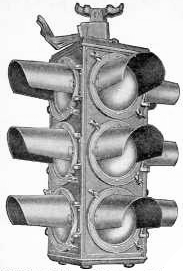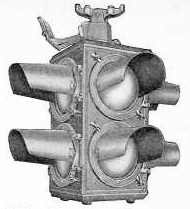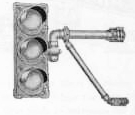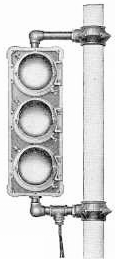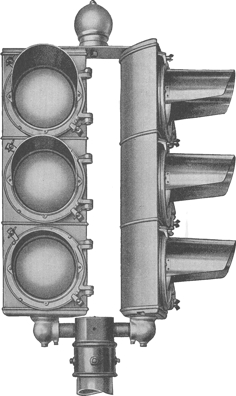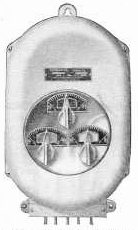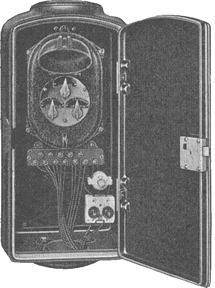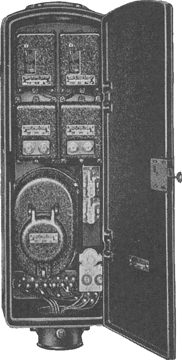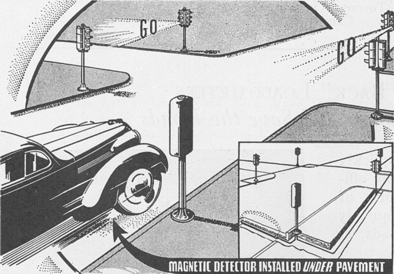Difference between revisions of "Tokheim"
| Line 12: | Line 12: | ||
All Tokheim signals were designed with several characteristics: | All Tokheim signals were designed with several characteristics: | ||
| − | + | All bodies are of cast aluminum | |
Felt gaskets are used on the lense and door | Felt gaskets are used on the lense and door | ||
Doors are portholes held in place with two L-clamps and wingnuts | Doors are portholes held in place with two L-clamps and wingnuts | ||
| Line 21: | Line 21: | ||
Wiring is done with rubber wire | Wiring is done with rubber wire | ||
Lamps are 50-Watt household or 60-Watt traffic bulbs | Lamps are 50-Watt household or 60-Watt traffic bulbs | ||
| − | + | ||
Tokheim signals also had several options available (Mainly four-way exclusives): | Tokheim signals also had several options available (Mainly four-way exclusives): | ||
| − | + | ||
Blank covers on one to three sides | Blank covers on one to three sides | ||
15°, 30°, or 45° angled doors | 15°, 30°, or 45° angled doors | ||
| − | Traffic Bell | + | Traffic Bell |
| Line 36: | Line 36: | ||
====Cut 1200 - Four-Way Aerial Traffic Control Signal==== | ====Cut 1200 - Four-Way Aerial Traffic Control Signal==== | ||
| − | TOK-CUT1200-LC.jpg | + | [[File:TOK-CUT1200-LC.jpg]] |
| − | |||
| − | |||
| + | '''Figure: Tokheim 1200 Signal. [Image by LC] | ||
| + | ''' | ||
====Cut 1260 - Four-Way, Two Color, Aerial Traffic Control Signal==== | ====Cut 1260 - Four-Way, Two Color, Aerial Traffic Control Signal==== | ||
| Line 46: | Line 46: | ||
| − | TOK-CUT1260-LC.jpg | + | [[File:TOK-CUT1260-LC.jpg]] |
| − | Figure: Tokheim 1260 Signal. [Image by LC] | + | '''Figure: Tokheim 1260 Signal. [Image by LC]''' |
====Cut 1300 - Four-Way, Post-Type, Traffic Control Signal==== | ====Cut 1300 - Four-Way, Post-Type, Traffic Control Signal==== | ||
| − | TOK-CUT1300-LC.jpg TOK-CUT1300B-LC.jpg | + | [[File:TOK-CUT1300-LC.jpg]] [[File:TOK-CUT1300B-LC.jpg]] |
| − | Figure: Tokheim 1300 Signal. [Image by LC] | + | '''Figure: Tokheim 1300 Signal. [Image by LC]''' |
| Line 69: | Line 69: | ||
| − | TOK-CUT1310-LC.jpg | + | [[File:TOK-CUT1310-LC.jpg]] |
| − | Figure: Tokheim 1310 Signal. [Image by LC] | + | '''Figure: Tokheim 1310 Signal. [Image by LC]''' |
====Cut 1400 - Horizontal Adjustable Post Bracket, Traffic Control Signal==== | ====Cut 1400 - Horizontal Adjustable Post Bracket, Traffic Control Signal==== | ||
| − | TOK-CUT1400-LC.jpg | + | [[File:TOK-CUT1400-LC.jpg]] |
| − | Figure: Tokheim 1400 Signal. [Image by LC] | + | '''Figure: Tokheim 1400 Signal. [Image by LC]''' |
| Line 86: | Line 86: | ||
| − | TOK-CUT1406-LC.jpg | + | [[File:TOK-CUT1406-LC.jpg]] |
| − | Figure: Tokheim 1406 Signal. [Image by LC] | + | '''Figure: Tokheim 1406 Signal. [Image by LC]''' |
====Cut 1410 - Vertical Adjustable Post Bracket, Traffic Control Signal==== | ====Cut 1410 - Vertical Adjustable Post Bracket, Traffic Control Signal==== | ||
| − | TOK-CUT1410-LC.jpg | + | [[File:TOK-CUT1410-LC.jpg]] |
| − | Figure: Tokheim 1410 Signal. [Image by LC] | + | '''Figure: Tokheim 1410 Signal. [Image by LC]''' |
| Line 103: | Line 103: | ||
| − | TOK-AdjSection-LC.jpg | + | [[File:TOK-AdjSection-LC.jpg]] |
| − | Figure: Tokheim sectional head. [Image by LC] | + | '''Figure: Tokheim sectional head. [Image by LC]''' |
== Pedestrian Signals == | == Pedestrian Signals == | ||
| Line 142: | Line 142: | ||
Intoduced in 1925, the model 1500 was a local timer for controlling traffic signals. | Intoduced in 1925, the model 1500 was a local timer for controlling traffic signals. | ||
| − | TOK-CUT1500-LC.jpg | + | [[File:TOK-CUT1500-LC.jpg]] |
| − | Figure: Tokheim 1500 Signal Timer. [Image by LC] | + | '''Figure: Tokheim 1500 Signal Timer. [Image by LC]''' |
| Line 152: | Line 152: | ||
| − | TOK-CUT1820-LC.jpg TOK-Controller-LC.jpg | + | [[File:TOK-CUT1820-LC.jpg]] [[File:TOK-Controller-LC.jpg]] |
| − | Figure: Tokheim 1820 Signal Controller. [Image by LC] | + | '''Figure: Tokheim 1820 Signal Controller. [Image by LC]''' |
| Line 162: | Line 162: | ||
| − | TOK-MagController-LC.jpg TOK-MagSetup-LC.jpg | + | [[File:TOK-MagController-LC.jpg]] [[File:TOK-MagSetup-LC.jpg]] |
| − | Figure: Tokheim magnetic detectors. [Image by LC] | + | '''Figure: Tokheim magnetic detectors. [Image by LC]''' |
==Hardware== | ==Hardware== | ||
Revision as of 02:32, 28 December 2013
Contents
- 1 Summary
- 2 Traffic Signals
- 2.1 Four Ways
- 2.2 Adjustables
- 2.2.1 Cut 1310 - One-Way, Post-Type, Traffic Control Signal
- 2.2.2 Cut 1400 - Horizontal Adjustable Post Bracket, Traffic Control Signal
- 2.2.3 Cut 1406 - One-Way, Vertical-Bracket Type, Traffic Control Signal
- 2.2.4 Cut 1410 - Vertical Adjustable Post Bracket, Traffic Control Signal
- 2.2.5 Sectional Signals
- 3 Pedestrian Signals
- 4 Informational Signals and Signs
- 5 Lenses
- 6 Controllers
- 7 Hardware
- 8 Miscellaneous Images
- 9 References
Summary
Formally known as the Tokheim Oil Tank and Pump Company during this era. An early entrant to the world of commercial signalling devices, they aquired Signaphore in 1926 and took over production as well as introduced new products such as controllers. By 1937 their interest in the product line wained and on January 8th, 1938 the transition of their signal intetrests to Automatic Signal took place, along with pioneering traffic engineer Reuben E. Bechtold.
Traffic Signals
All Tokheim signals were designed with several characteristics:
All bodies are of cast aluminum Felt gaskets are used on the lense and door Doors are portholes held in place with two L-clamps and wingnuts All visors were cutaways with 8" length Reflectors are thick glass with an electrolytic copper plating Reflectors are held in a pan and mounted to the signal body Sockets are a porcelain Leviton wing style Wiring is done with rubber wire Lamps are 50-Watt household or 60-Watt traffic bulbs
Tokheim signals also had several options available (Mainly four-way exclusives):
Blank covers on one to three sides 15°, 30°, or 45° angled doors Traffic Bell
Four Ways
Cut 1200 - Four-Way Aerial Traffic Control Signal
Figure: Tokheim 1200 Signal. [Image by LC]
Cut 1260 - Four-Way, Two Color, Aerial Traffic Control Signal
No Yellow/Caution Lens
Figure: Tokheim 1260 Signal. [Image by LC]
Cut 1300 - Four-Way, Post-Type, Traffic Control Signal
Figure: Tokheim 1300 Signal. [Image by LC]
Sectional Signals
At some time, 4-way sectional heads were also made.
Adjustables
Cut 1310 - One-Way, Post-Type, Traffic Control Signal
Also available in two to five way clusters. Solid Body
Figure: Tokheim 1310 Signal. [Image by LC]
Cut 1400 - Horizontal Adjustable Post Bracket, Traffic Control Signal
Figure: Tokheim 1400 Signal. [Image by LC]
Cut 1406 - One-Way, Vertical-Bracket Type, Traffic Control Signal
Also available in two to four way clusters. Solid Body
Figure: Tokheim 1406 Signal. [Image by LC]
Cut 1410 - Vertical Adjustable Post Bracket, Traffic Control Signal
Figure: Tokheim 1410 Signal. [Image by LC]
Sectional Signals
This is a sectional signal head made by Tokheim.
Figure: Tokheim sectional head. [Image by LC]
Pedestrian Signals
Tokheim did not manufacture any pedestrian signals.
Informational Signals and Signs
describe models, variations [delete] includes "box signs," "case signs," and Ped Heads with special [non-ped] lenses.
Lenses
Lenses are 8 3/8" dia. with a 90° diffusing pattern. Command lenses are optional, with embossed letters two inches high, and a baked enamel finish.
Controllers
Controllers were individually settable for the Red, Yellow, and Green phases. Stop and Go could be set for anywhere from 15 sec. to 3 minutes. The clearance, yellow, could be set from two seconds to seven[?] seconds.
Cut 2000 - Chronoplan
Not a controller in itself, but the Tokheim guide on installation and setup of a traffic controller system utilizing a Chronolizer and several 1500 Timer modules. Improvements of up to 94% over the synchronized system and 43% over the staggered controller systems were guaranteed for a car doing the speed limit.
Chronolizer - Central Controller
This was a device attached to a series of 1500 timers to control a full roadway of signals in interoperation and coordination.
Cut 1500 - Traffic Signal Timer
Intoduced in 1925, the model 1500 was a local timer for controlling traffic signals.
Figure: Tokheim 1500 Signal Timer. [Image by LC]
Cut 1820 - Automatic Traffic Signal Control
The model 1820 was essentially a 1500 timer and associated circuitry in a cabinet to allow isolated operation of a single signal or intersection.
Figure: Tokheim 1820 Signal Controller. [Image by LC]
Magnetic Detector
Part of the later signal line upgrades included early magnetic detectors for vehicle-actuation. Following is an example of the controller with magnetic detection modules and a marketing image of an intersection configured as such.
Figure: Tokheim magnetic detectors. [Image by LC]
Hardware
this would include any kind of mounting hardware including brackets, slipfitters, hangers, bases, etc. [delete]
Miscellaneous Images
a couple of quality pics of a restored unit [delete]
References
Insert any sources cited or used here [delete]
